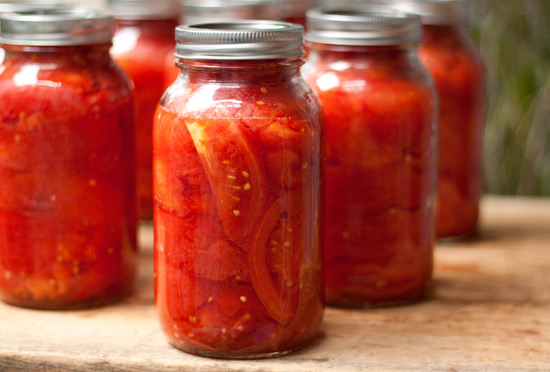Canning tomatoes yourself is an easy way to produce a healthy supply of whole, crushed or diced tomatoes for your family, as well as sauces and juice. So many commercially available canned tomatoes are often full of sodium and preservatives. Making your own is a healthy alternative. Home canning tomatoes is also a cost effective way to stock up on healthy canned goods.
This guide will walk you through every aspect of canning tomatoes, from choosing the best tomatoes to can, to how to can tomatoes using a pressure canner or boiling water bath. We’ll give you great recipes for canning tomatoes of all shapes and sizes, as well as recipes for using canned tomatoes.
- Best Tomatoes for Canning
- How to Can Tomatoes
- Canning with a Pressure Canner
- Canning without a Pressure Canner
- Recipes for Canning Tomatoes
- 5 Secrets to Successful Canning
- Canning Troubleshooting
- Tools for Home Canning
- 5 Recipes Using Canned Whole Tomatoes
Best Tomatoes for Canning
If you want delicious canned tomatoes, you have to start with the best tomatoes. While big, juicy tomatoes like Beefeaters are some of the most popular additions to salads and sandwiches. Canned tomatoes are typically used for sauces, soups and stews. Tomatoes that have a high water content require more cooking to make a nice sauce. Longer cooking times destroy the vitamins in the tomatoes. For a higher quality sauce, the best canning tomatoes are paste varieties.
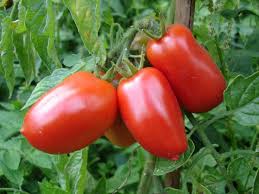
Image courtesy of canned-fresh.com
Best Paste Tomato Varieties for Canning
Paste tomatoes are drier than other varieties, with lots of meat and few seeds. Their dryness concentrates their flavor, making a richer, tastier base for sauces, stews or soups. If you are canning tomatoes at home, you should use the best paste tomatoes you can find. Traditional Romas are readily available at the supermarket, but there are a lot of other types of delicious paste tomatoes you can find at farmer’s markets or at a local farm.
Here are some of the most popular varieties for canning tomatoes.
- Roma – The classic paste tomato, the Roma is a determinate variety. This means that all the tomatoes ripen at the same time, which makes them perfect for home canning. If you are growing your own tomatoes in your kitchen garden, your Romas will all be ready for harvest at once so you can mix up a big batch of sauces and preserves in one go.
- San Marzano – San Marzano tomatoes are the ancestor of Romas. This heirloom paste variety is easy to grow in warm climates, and has a thinner skin than the Roma. The meat is heavy and flavorful.
- Big Mama – The Big Mama lives up to her name. These extra large paste tomatoes are some of the largest producers per square foot of garden space. Just imagine how much time you’ll save on peeling with these 5 inch long tomatoes.
- Jersey Giant – The Jersey Giant is even larger than the Big Mama. It is shaped like a pepper, but the flavor is all tomato. They are rich, meaty paste tomatoes with a hearty flavor that will bring summer into your kitchen all winter long.
- Amish Paste – A plum heirloom tomato of Amish origins, the Amish Paste tomato looks like a Roma, but the flavor is sweeter.
- Juliet – Extra sweet, meaty and high yielding, the Juliet is somewhere between a Roma and a cherry tomato. While these little tomatoes require a lot of peeling, the rich flavor they lend your favorite sauces is worth the effort.
Types of Canned Tomatoes
There are seven basic types of canned tomatoes. You can replace every one of these common supermarket cans with healthy, delicious home canned tomatoes.
- Whole Canned Tomatoes – You should always have peeled, whole canned tomatoes in your pantry. They are easily cooked down into sauce, added to soups or even tossed in the blender to make a delicious summery salsa in January.
- Diced Canned Tomatoes – These are some of the hardest to make at home, as the diced tomatoes tend to lose their shape. The canned diced tomatoes you find at the grocery store often contain calcium chloride which helps the tomatoes retain their shape.
- Crushed Canned Tomatoes – Making crushed tomatoes at home is easy, as tomatoes break down while cooking and can be easily smashed with a spoon. They have a bright flavor and are perfect for sauce making.
- Stewed Tomatoes – These are seasoned crushed tomatoes. They typicallly have onions, peppers, garlic and salt and pepper added. Stewed tomatoes are handy to have in the cupboard because they make whipping up a sauce extra easy.
- Tomatoe Puree – These are just tomatoes that have been ground a bit smoother than crushed tomatoes. They are used interchangeably.
- Tomato Sauce – This is the smooth, pour-able tomato product that you can use to make enchiladas. It is often mixed up at home by combining tomato paste and water.
- Tomato Paste – Tomato paste is highly reduced, with nearly all the water cooked out of it. This results in a thick paste with a highly concentrated flavor.
RELATED: Safely Canning Spaghetti Sauce with Meat
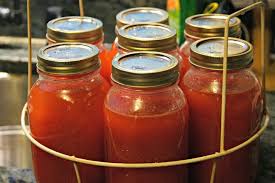
Image courtesy of thefrugalgirl.com
How to Can All Types of Tomatoes
There are several ways to can tomatoes. You can use a pressure canner or a boiling water bath to can tomatoes, tomato juice or tomato sauce. Boiling water bath canning is the traditional method for canning tomatoes. However, pressure canning is faster and you don’t have to acidify the tomatoes if you use pressure canning, because the high levels of heat achieved in a pressure canner quickly destroy any bacteria present in the jar.
We’ll discuss canning tomatoes step-by-step using a pressure canner and a boiling water bath. But first, there are a few things to consider about canning tomatoes in general.
How to Sterilize Jars for Canning Tomatoes
Most home canners carefully sterilize their jars before canning tomatoes. This helps limit the growth of mold or bacteria in the jars. However, according to the National Center for Home Food Preservation, it is not necessary to pre-sterilize jars for canning tomatoes if the jars will be processed in a pressure canner or for over ten minutes in a water bath canner. Never use jars or lids that are chipped or cracked.
To sterilize empty jars for canning tomatoes you can use one of two different methods:
- Boiling Water – Place the jars right side up on the rack of a boiling-water canner or in a large pot. Fill both the canner and jars with hot but not boiling water so that the water covers the jars by one inch. Boil for ten minutes. Boil for an additional minute for each additional 1,000 feet of elevation.
- Oven – Preheat the oven to 225°F. Place jars, lids and rings on cookie sheets, being careful to arrange them so they don’t touch. Cook at 225°F for ten minutes.
Hot Pack vs. Cold Pack for Canning Tomatoes
When you are canning tomatoes using a pressure canner you can either hot or cold pack them. The choice is yours and depends largely on the final product you desire.
- Hot Packing Tomatoes – This process is best for canning tomato juice, crushed tomatoes and tomato sauce. You can also hot pack whole, halved or diced tomatoes.
- How to Hot Pack Canned Tomatoes – Place tomatoes in a heavy bottomed sauce pan and cover with enough tomato juice or water to cover. Boil gently for five minutes, and pour boiling mixture directly into the prepared jars.
- Cold Packing Tomatoes – This process, also called raw packing, is commonly used for canning tomatoes whole, halved or diced in tomato juice or water.
- How to Cold Pack Canned Tomatoes – Fill each jar with raw tomatoes, leaving 1/2 inch of headspace. Heat the tomato juice or water in a saucepan. Pour hot juice or water into the jar, leaving 1/2 inch headspace.
Canning Tomatoes with a Pressure Canner
Pressure canning tomatoes is fast and easy. Pressure canning allows you to reduce the canning time for tomatoes which results in a higher quality final product. You can use a pressure canner for canning whole, halved, diced or crushed tomatoes, or tomato juice, sauce or stewed tomatoes. You can even process meaty pasta sauce safely using a pressure canner.
Pressure Canner vs. Pressure Cooker
A lot of people get confused by the difference between pressure canners and pressure cookers. The simple distinction is that pressure canners are specifically designed for canning tomatoes and other fruits and vegetables. They are more accurate at monitoring pressure and temperature. To safely can tomatoes, it is essential to be able to precisely control the temperature and pressure of the canner. These parameters must be set clearly and maintained during the entire canning process.
Because botulism is a very real and dangerous threat when canning tomatoes, it is important to use a pressure canner. Canning tomatoes with a pressure cooker doesn’t allow you to be certain that you have destroyed all the harmful bacteria in the tomatoes. The National Center for Home Food Preservation advises against using a pressure cooker for canning any type of fruit or vegetables.
Can Tomatoes with a Pressure Canner
Here is a step by step guide to safely canning tomatoes using a pressure canner:
- Sterilize jars and lids.
- Choose ripe, firm tomatoes. Dip each tomato into boiling water for 30 seconds, then place in an ice bath. Cut the stems and peel the skins off the tomatoes.
- Add 1/2 teaspoon citric acid, 2 tablespoons lemon juice or 4 tablespoons vinegar per quart (halve these amounts if you are using pint jars). Even though canning tomatoes with a pressure canner greatly reduces the risk of botulism, it is still important to acidify the canned tomatoes. This allows you to use lower cooking times, resulting in a higher quality final product.
- Follow instructions above for either hot or cold packing tomatoes.
- Wipe jars with a damp cloth and secure the lids.
- Place 2-3 inches of hot water in the pressure canner, and stand jars on the rack insert so they are not touching one another.
- Fasten the lid of the pressure canner and turn on the heat.
- Start the processing time when your canning pressure has been reached.
- Close the regulator and maintain a constant temperature throughout canning.
- When processing time is up, remove the canner from heat and allow pressure to return to zero. Do nothing to rush this process.
- Cooling can take 30-45 minutes. If you rush cooling you can break the seals or damage the pot.
- After the pressure reaches zero, wait two more minutes and then open the regulator.
- Unfasten cover and open the side facing away from you to allow any remaining steam to escape.
- Remove jars of canned tomatoes using a jar lifter. Place on a dry towel, leaving space between jars for circulation.
For specific pressures and times for pressure canning tomatoes, check out these recipes for canning tomatoes.
Altitude Adjustments for Pressure Canning
The following recipes give times for canning tomatoes at sea level. If you are canning tomatoes at a higher elevation, make the following adjustments:
- Dial Gauge Pressure Canner – The processing time stays the same, but the canner pressure must increase:
- 1001-2000 Feet: Increase pressure to 11.
- 2001-4000 Feet: Increase pressure to 12.
- 4001-6000 Feet: Increase pressure to 13.
- 6001-8000 Feet: Increase pressure to 14.
- 8000-10,000 Feet: Increase pressure to 15.
Can Tomatoes Without a Pressure Cooker
Canning tomatoes the old way, without a pressure cooker, means using a simple hot water bath. For centuries people have canned tomatoes, tomato sauces, salsas and stewed tomatoes using nothing more than a pot of hot water. You can still use this method safely and effectively in your own home.
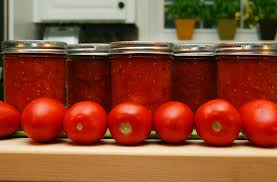
Image courtesy of growingagreenerworld.com
Is Water Bath Canning Safe?
Improperly canned foods can grow botulism, a bacteria which produces a deadly toxin that is nearly impossible to detect. Highly acidic environments inhibit the growth of botulism, so high acid foods like most fruits can be safely canned in a water bath. Low acid foods require the added heat of pressure canning to kill any botulism spores. For a long time, tomatoes were considered a high acid food and safe for water bath canning. However, the acidity of tomatoes varies widely based on type, ripeness, soil and even manner of harvesting. Since 1983 the FDA regulations recommend acidifying the mixture before canning tomatoes with a water bath, or canning tomatoes with a pressure cooker.
A Note on Stewed Tomatoes
If you add vegetables to your canned tomatoes, like you do when you make stewed tomatoes, you must can them with a pressure canner. Even adding citric acid or lemon juice will not sufficiently acidify a mixture of tomatoes and other vegetables and the risks of botulism developing are higher. Acidified water bath canning is safe for canning pure tomatoes.
RELATED: All About Canning Stewed Tomatoes
The Process with a Boiling Water Bath
If you will be canning tomatoes with a hot water bath, always hot pack them. Cold packing increases the risks associated with water bath canning. It is important to sterilize the jars properly and to acidify the tomatoes before placing them in the hot water canner.
Here are step by step instructions for canning tomatoes using a boiling water canner:
- Sterilize jars and lids.
- Choose ripe, firm tomatoes. Dip each tomato into boiling water for 30 seconds, then place in an ice bath. Cut the stems and peel the skins off the tomatoes.
- Cut the peeled tomatoes into quarters, place in a heavy bottomed pan and cook to a boil.
- Pour boiling fruit into sterilized canning jars, leaving a half inch of head space at the top of each jar.
- Add 1/2 teaspoon citric acid, 2 tablespoons lemon juice or 4 tablespoons vinegar per quart (halve these amounts if you are using pint jars).
- Wipe jars with a damp cloth and secure the lids.
- Place jars into water bath canner with boiling water. Add enough boiling water to cover the tops of the containers by one to two inches. Be sure not to pour water directly onto the jars.
- Process for the appropriate amount of time, beginning when the water in the canner is at a roiling boil. See canning tomato recipes below for specific processing times.
- Boil gently but steadily for the whole time. Add boiling water as necessary to keep jars covered.
- Remove jars of canned tomatoes immediately when processing time is up.
If You Don’t Have a Water Bath Canner
You plan on processing a lot of canned tomatoes, a water bath canner is worth purchasing. However, in a bind you can use a heavy bottomed saucepan and a rack. Even a cake cooling rack works well. The pot has to be large enough to fully surround the jars with boiling water. The rack keeps the jars off the bottom of the pan and allows water to circulate around the jars. If they are directly on the bottom of the pot the jars will break.
Adjusting Water Bath Canning Times for Altitude
Just like with pressure canning, canning tomatoes with a water bath requires different amounts of time based on the altitude at which you are canning.
Here is a quick reference to adjust canning times based on altitude:
- 1000 to 3000 feet: add 5 minutes
- 3000 to 6000 feet: add 10 minutes
- 6000 to 8000 feet: add 15 minutes
- 8000 to 10000 feet: add 20 minute
Testing the Seal on Canned Goods
After the jars of canned tomatoes have cooled, it is important to test each lid to make sure they are properly sealed. There are three simple tests to check the seal:
- Press the Center of the Lid – If it pops under your finger, the jar is not sealed.
- Tap the Lid with a Spoon- A properly sealed lid will give a clean, ringing sound. A dull, thudding sound means the lid is not sealed.
- Appearance – The lid of properly canned tomatoes should have a concave appearance.
If the lid is not properly sealed, you must either reprocess the jar (within 24 hours) or place it in the refrigerator and eat within 3-5 days. Before reprocessing a jar of canned tomatoes, carefully check the lid and jar for nicks or faults. It is best to use a new lid, even if you don’t see any damage. Reprocess the jar of canned tomatoes using the same method you used originally. Label the jar as being reprocessed, and use it first.
Storing Canned Goods
Canned tomatoes should be stored in a dry, dark place between 50-70°F. Canned tomatoes can be stored safely for over a year, though after 10-12 months the nutritional value of any canned good deteriorates. Never consume canned tomatoes from a can that is bulging, dented or rusty.
Recipes for Canning Tomatoes
Here are some specific recipes you can use for canning tomatoes using a boiling water canner or a pressure canner.
Canning Raw Packed Whole or Halved Tomatoes
Preparation of raw packed whole or halved tomatoes:
- Wash tomatoes thoroughly. Dunk into boiling water for 30 seconds until skins split, and place in ice water.
- Remove skin an cores. Leave tomatoes whole or cut them in half.
- Add lemon juice or citric acid to sterilized canning jars. If desired, add 1 teaspoon of salt or sugar per quart jar.
- Fill jars with raw tomatoes, leaving 1/2 inch of headspace. Press them into jars until the spaces between them fill with juice.
- Wipe jar rims and put on lids.
Processing raw packed whole or halved tomatoes:
- Boiling Water Bath – 85 minutes for pints or quarts.
- Dial Gauge Pressure Canner – 11 pounds of pressure for 25 minutes for pints or quarts.
- Weighted Gauge Pressure Canner – 10 pounds of pressure for 25 minutes for pints or quarts.
RELATED: Recipes for Canning Tomato Sauce
Canning Whole or Halved Tomatoes Packed in Water
Preparation of whole or halved tomatoes packed in water:
- Wash tomatoes thoroughly. Dunk into boiling water for 30 seconds until skins split, and place in ice water.
- Remove skin an cores. Leave tomatoes whole or cut them in half.
- Add lemon juice or citric acid to sterilized canning jars. If desired, add 1 teaspoon of salt or sugar per quart jar.
- For Hot Pack: Cover tomatoes with water and boil for five minutes. Fill Jars with hot tomatoes and add the hot cooking liquid, leaving 1/2 inch of headspace.
- For Raw Pack: Heat water to a boil. Pack raw tomatoes into hot jars, leaving 1/2 inch headspace. Fill hot jars to 1/2 inch from the top with boiling water
- Wipe jar rims and put on lids.
Processing whole or halved tomatoes packed in water:
- Boiling Water Bath – 40 minutes for pints, 45 minutes for quarts.
- Dial Gauge Pressure Canner – 11 pounds of pressure for 10 minutes for pints or quarts.
- Weighted Gauge Pressure Canner – 10 pounds of pressure for 10 minutes for pints or quarts.
RELATED: Four Best Tomato Canning Recipes
Canning Whole or Halved Tomatoes Packed in Tomato Juice
Preparation of whole or halved tomatoes packed in tomatoe juice: Follow instructions above for canning whole or halved tomatoes packed in water, substituting tomato juice for the water.
Processing whole or halved tomatoes packed in tomato juice:
- Boiling Water Bath – 85 minutes for quarts or pints.
- Dial Gauge Pressure Canner – 11 pounds of pressure for 25 minutes for pints or quarts.
- Weighted Gauge Pressure Canner – 10 pounds of pressure for 25 minutes for pints or quarts.
Canning Crushed Tomatoes with No Added Liquid
This recipe allows the canned tomatoes to be processed quickly, making a high quality product that is tasty in stews, soups and sauces.
Preparation of crushed tomatoes:
- Wash tomatoes thoroughly. Dunk into boiling water for 30 seconds until skins split, and place in ice water.
- Remove skin and cores. Quarter.
- Heat 1/6 of the tomato quarters in a large pot over high heat, crushing them with a spoon as you add them to draw out the juice. Continue to heat, stirring constantly.
- When the tomatoes are boiling, add the other tomato quarters.They don’t need to be crushed as they will soften with heating. After all tomatoes are added, cook for 5 minutes.
- Add lemon juice or citric acid to sterilized canning jars. If desired, add 1 teaspoon of salt or sugar per quart jar.
- Wipe jar rims and put on lids.
Processing whole or halved tomatoes packed in water:
- Boiling Water Bath – 35 minutes for pints, 45 minutes for quarts.
- Dial Gauge Pressure Canner – 11 pounds of pressure for 15 minutes for pints or quarts.
- Weighted Gauge Pressure Canner – 10 pounds of pressure for 15 minutes for pints or quarts.
RELATED: Recipes for Canning Tomato Juice
5 Little Known Secrets for Successfull Canning
Whether you are canning tomatoes with a pressure canner or a water bath canner there are a few tricks you can use to make canning tomatoes simpler and easier. These 5 secrets for a trouble free canning session work well on crushed tomatoes, spaghetti sauce, stewed tomatoes and more:
- Fill the Jars with the Rings On – This helps keeps the rims of the jars of canned tomatoes clean while you’re filling them so you don’t have the hassle of wiping them down later on.
- Fill the Jars Using a Measuring Cup – This speeds up the whole jar filling process. Plus you know how much to place in each jar: for instance, a pint jar takes two cup scoops.
- Screw the Lids on “Finger Tight” – Only tighten the lids till you feel the first bit of resistance, or till they are “finger tight”. No matter how well you pack the canned tomatoes into the jars, a few air bubbles will be trapped inside. If the lids are a bit loose they can escape during processing. The lids will form a strong seal as the jars cool.
- Remove the Rings after the Jars Are Sealed – You don’t need them any more! After the jars have cooled entirely, the lids will be so firmly sealed that you can lift the jar by the lid alone. Removing the rings will keep them from rusting and make them available for your next batch of canning tomatoes. Plus you can see potential problems sooner. If your canned tomatoes begin to ferment, the lids pop right off.
- Label Jars with a Batch Number – If you are planning on making several batches of canned tomatoes be sure to label each jar with a batch number. That way you can be sure to use the oldest jars first, and if any problems arise in one jar you’ll easily be able to tell which other jars to check.
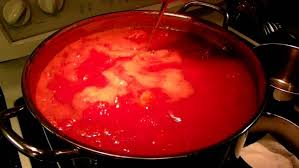
Image courtesy of youtube.com
Troubleshooting
There are a variety of common problems that may come up when you first get started canning tomatoes. Over time you’ll find the perfect procedure for your canning equipment. Until you do, here are a couple of the most common problems with canning tomatoes and how to fix them:
Tomatoes Separate from the Liquid
This can occur in two different ways, each of which calls for its own solution.
The Problem: Liquid is at the top, tomatoes are at the bottom.
This occurs if the canned tomatoes are packed in their own juice, when the juice is extracted from the raw tomatoes. There is an enzyme in tomatoes that causes the separation of juice and solids which is activated by air an deactivated by heat.
The Fix: Leave tomatoes whole or in halves or quarters (not diced) and heat before chopping or juicing. The best way is to quickly heat halved or quartered tomatoes to boiling quickly, while crushing them with a wooden spoon. Simmer for five minutes and then juice the crushed tomatoes.
The Problem: Tomatoes are at the top, liquid is at the bottom.
The reverse scenario occurs with too much preheating (say, boiling the tomatoes for more than five minutes) which breaks down the pectin in canned tomatoes.
The Fix: Don’t overcook your tomatoes before canning. If separation does occur, simply shake the canned tomatoes before opening, or decant the water from the top of the jar before using the tomatoes.
Jars Lose Liquids During Canning
The Problem: You remove the jars of canned tomatoes from the canner only to discover that they lost their liquid and were nearly half empty. This could be caused by several things:
- The tomatoes were cold packed.
- The tomatoes were packed too tightly into the jars.
- There were air bubbles in the jars.
- The canner cooled too quickly.
- The jars were filled too fill.
- Pressure canner pressure levels fluctuated. Make sure to decrease the pressure to zero gradually. Don’t rush cooling with cold water.
If the jars have sealed well, you can still eat the canned tomatoes even if this happens. Just be sure to check the jars regularly for signs of a broken seal, and use these canned tomatoes first.
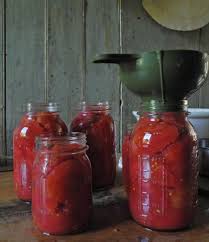
Image courtesy of altoonsultan.blogspot.com
Tools for Home Canning
There are few essential tools for canning tomatoes. Even if you are simply canning tomatoes using a large pot instead of a pressure or water bath canner, there are a few tools that will make the job easier. Here are some that should find their way into your kitchen before you begin canning tomatoes:
- Jar Rack – A jar rack keeps the jars from touching one another, and from touching the canner. If the jars touch anything while you are processing canned tomatoes it can cause them to shatter.
- Lid Wrench – A good lid wrench with padded handles is perfect for opening or tightening lids of canned tomatoes. However, they shouldn’t be used to over tighten a lid before processing, as this will stop air bubbles from escaping. Use them to open extra tightly sealed jars later on.
- Funnel – A funnel makes filling your canning jars easier and mess free. Don’t waste time wiping the rims of each lid or make a mess of spilled canning tomatoes.
- Tongs – Use a good pair of tongs to lift hot jars out of the water bath canner or pressure cooker.
- Jar Lifter – Replace your standard tongs with a jar lifter. This tool is specifically designed for canning jars and grasps them tightly. Regular tongs can slip or skid on a jar of canned tomatoes.
- Magnetic Lid Lifter – This simple tool will save your fingertips countless burns. Use it to lift lids out of boiling water after sterilizing them.
- Bubble Popper – A bubble popper makes removing air bubbles from your jars before processing easy. Most have a measuring mark as well to help you leave the perfect amount of head space in each jar of canned tomatoes.
Here are a few great products that will help you get started canning tomatoes at home today:
- 9 Piece Enamel on Steel Home Canning Kit – This complete home canning kit includes a 21 quart canner with lid, a 7 jar rack, a 9 inch colander, a lid wrench, funnel, tongs, jar lifter and a magnetic lid lifter.
- 6 Piece Home Canning Kit – If you already have a canner pick up this set of essential extras: jar wrench, jar lifter, extra wide mouth funnel, tongs, bubble popper and a magnetic lid lifter all together at a low price.
- 23 Quart Pressure Canner – This extra large canner is great for big processing days. It has a precise dial gauge that is essential for high altitude canning.
5 Easy Recipes for Canned Whole Tomatoes
Remember how I said that having a can of whole tomatoes on hand is incredibly handy? Canned tomatoes, whole or otherwise, can be easily transformed into a number of delicious and creative meals. Here are five of my favorites. I haven’t included detailed instructions, because these recipes can be adapted to your personal tastes. The beauty of canning tomatoes is that quality canned tomatoes give you many opportunities to make delicous dishes. These five ideas are great starting points. Adapt the flavors, herbs and spices to create your own new and varied dishes:
1. Simple Tomato Sauce
This is as easy it a tomato sauce recipe gets, and it is delicious. All you need are canned tomatoes, butter, salt and onion. Cut the onion in half, add all ingredients to a sauce pot and simmer for 45 minutes. Remove the onion and serve on your favorite pasta or add to your grandma’s lasagna recipe.
2. Creamy Tomato Soup
As you cook your canned tomatoes they will become soft. You can simply crush whole canned tomatoes with a spoon while they cook. Add herbs like basil, oregano or marjoram and spices like garlic powder, red pepper, onion powder or black pepper. Add fresh milk (cow, goat, coconut or even almond milk work wonderfully) or a bit of cream at the end for a rich soup. Serve with garlic bread, a fresh salad or grilled cheese sandwiches.
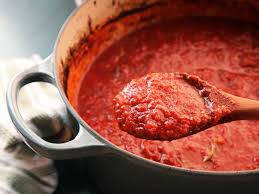
Image courtesy of serious-eats.com
3. Turkey Chili with Kale
Brown the meat with onions, celery and garlic. Add the tomatoes (beans if you like) and simmer. Save the kale for the end and just cook it till it is soft. You can make chili using ground turkey, ground beef or ground bison.
4. Vegetarian Curry
If you love curry but are intimidated by complex recipes, start with this one. Start with 1 teaspoon each of the spices and adjust to taste at the end. Simply saute 1 large chopped onion in oil till they are translucent. Add cubed red potatoes and cook till browned. Add chopped cauliflower and salt to taste. Toss in cumin, curry powder, tumeric and minced garlic. Add canned tomatoes and bring to a boil. Cook for 20 minutes. If the tomatoes are watery, remove the lid during the last 5-10 minutes to thicken the sauce. At the end mix in Greek yogurt and adjust seasonings to taste.
5. Moroccan Stewed Chicken
This fast and easy stewed chicken with canned tomatoes recipe is delicious. Saute 1 large chopped onion till soft, and then add 4 cloves of chopped garlic, 1 teaspoon coriander seeds and 2 teaspoons each of paprika and oregano. Add canned tomatoes and canned tomato paste, cinnamon and preserved lemon. Add chicken and simmer for 30 minutes. Add salt, pepper and parsley if needed.
Get creative with your canned tomatoes with one of these unique ideas.
Ready to start canning tomatoes? Follow along with these fun Southern chefs as they use a variety of methods to can fruits and vegetables. Canning tomatoes doesn’t get much more fun than this.

